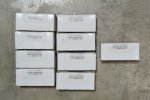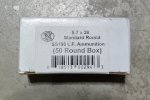even more INFO:
Cartridge types
SS90 prototype
The SS90 was an early prototype round used only in the earliest examples of the P90. It used a lightweight 1.5-g (23 grain) full metal jacket bullet with a polymer core, which it propelled at a muzzle velocity of roughly 850 m/s (2,800 ft/s). The SS90 was abandoned in 1994 in favor of the heavier and shorter 2.7 mm (0.11 in) SS190 projectile.[25]
SS190 duty
The SS190 FMJ, a refinement of the SS90, was introduced in 1993.[6] It offered superior performance over the prototype projectile as well as slightly reduced length.[6] The latter change allowed it to be used more conveniently in the Five-seven pistol, also being developed at that time.[25] Fired from the P90, the SS190 propels a 2.0-g (31 grain) bullet at a muzzle velocity of roughly 715 m/s (2,350 ft/s). It has a steel penetrator and an aluminum core.[52] The SS190 has been manufactured with a plain, black, and a black-on-white tip color.[17][53][54] It is classified by the ATF as armor-piercing (AP) handgun ammunition, and its sale is currently restricted by FN to military and law enforcement customers.[17][33]
In testing done by Houston Police Department SWAT, the SS190 fired from the P90 into bare ballistic gelatin exhibited penetration depths ranging from 28 to 34 cm (11 to 13.5 in).[29] In testing in 1999 by the Royal Canadian Mounted Police (RCMP), the SS190 fired from the P90 at a distance of 25 m (27 yd) exhibited an average penetration depth of 25 cm (9.85 in) in ballistic gelatin after passing through a Level II Kevlar vest.[50]
L191 tracer
The L191 (also formerly called the SS191)[55] is a tracer cartridge designed for easier bullet spotting in dim light.[17] Combustible chemicals packed in the rear of the L191 projectile create a light trail visible up to 200 m (219 yd).[54] The L191 has been manufactured with red and red-on-black tips.[17][53] The performance and trajectory of the L191 is identical to the SS190.[41][43] For this reason, it is also classified by the ATF as armor-piercing handgun ammunition, and its sale is currently restricted by FN to military and law enforcement customers.[17][33]
SS192 hollow-point
The SS192 was discontinued in late 2004.[55] It used a 1.8 g (28 grain) hollow point bullet with a copper jacket and an aluminum core.[32] The projectile had a length of 21.6 mm (.85 in).[32] It had an unmarked hollow nose with a depth of 7.6 mm (0.3 in) and a 0.8 mm (0.03 in) opening.[32] The SS192 was classified by the ATF as not armor-piercing, and in testing by FNH USA it did not penetrate a Level IIIA vest when fired from the Five-seven.[33]
SB193 subsonic
The SB193 (also formerly called the SS193)[55] is a subsonic cartridge featuring a 3.6-g (55 grain) Sierra Game King FMJBT (FMJ boat tail) projectile. The SB193's sub-sonic speed eliminates the distinctive "crack" created by supersonic rounds. The muzzle report is also reduced when using the sub-sonic ammunition together with a suppressor. Due to the greatly decreased muzzle velocity, the SB193 benefits from a slightly reduced recoil force of 1.3 kgm/s.[56] The SB193 can be identified by its white tip color.[17] Its sale is currently restricted by FN to military and law enforcement customers.[17]
T194 training
The T194 training round was discontinued in 2002. It could be considered an early version of the SS192 or SS195. It used the same 1.8-g (28 grain) copper-jacketed aluminum core bullet, propelled at the same muzzle velocity.[41] It had a green tip.[41]
SS195LF (lead free)
The SS195LF is a commercially available cartridge that features a lead-free primer and produces ballistics similar to the SS192 round, which it replaced in late 2004.[55] It uses the same 1.8-g (28 grain) copper-jacketed aluminum core bullet as the SS192, and it can be identified by the unmarked, hollow void at the tip and the silver-colored primer.[17] The SS195 is classified by the ATF as not armor-piercing, and it is currently manufactured by FN Herstal in Belgium.[10][33]
SS196SR (sporting round)
The SS196SR was introduced in 2005 and it is now discontinued in favor of the SS197SR cartridge.[34] It featured a lead core 2.6-g (40 grain) Hornady V-Max bullet which it propelled at a muzzle velocity of roughly 500 m/s (1,650 ft/s) when fired from the Five-seven.[34] The polycarbonate tip used in the V-Max bullet acted as a wedge, enhancing expansion of the bullet. The SS196 was classified by the ATF as not armor-piercing, and in testing by FNH USA it did not penetrate a Level II vest when fired from the Five-seven.[33] The SS196 could be identified by its red polymer tip.[55]
SS197SR (sporting round)
Photo of the 5.7×28mm SS197SR cartridge next to a 5.56×45mm NATO cartridge. The 5.56×45mm cartridge is significantly larger.
SS197SR (left) and 5.56×45mm NATO (right)
The SS197SR is currently offered to civilian shooters in addition to the SS195LF.[17] It uses the same lead core 2.6-g (40 grain) Hornady V-Max projectile as the SS196SR,[10] but it is loaded for a muzzle velocity roughly 30-m/s (100 ft/s) higher. The projectile has a blue-colored polymer tip instead of the red color used in the SS196 projectile tip.[17] The SS197 has been manufactured by Fiocchi, under contract for FN Herstal, since 2006[10][57][58] and it is distributed in the United States by Federal Cartridge Company.[17]
SS198LF (lead free)
The SS198LF uses the same lead-free projectile and primer as the SS195LF,[53] but propels it at roughly a 30-m/s (100 ft/s) higher muzzle velocity. It’s manufactured in Belgium. It has a green painted tip, and its sale is currently restricted by FN to military and law enforcement customers,[17] but is widely available through retailers to civilian customers.[citation needed]
American Eagle (AE5728A) TMJ
Since 2012, Federal Cartridge Company markets a loading produced by Fiocchi using a 5.7×28mm round under their American Eagle brand.[20] Designated the AE5728A, this cartridge uses a 40-grain total metal jacket (TMJ) projectile, that is atypical in that it does not use a copper-plated bullet; sectioned pictures show a very thick full copper jacket. The AE5728A casings are of FN manufacture, and the muzzle velocity is slightly lower than that of the SS197SR.[59]




